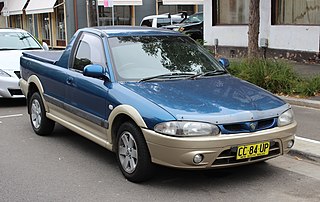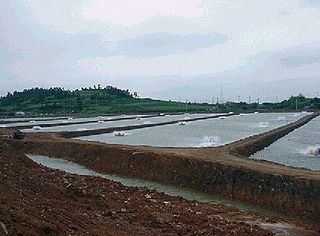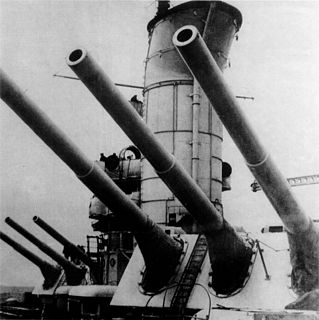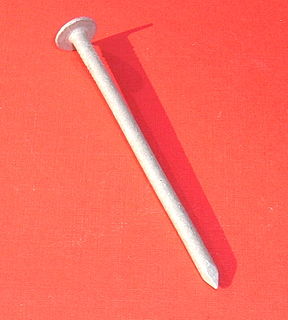
Wool classing is the production of uniform, predictable, low-risk lines of wool, carried out by examining the characteristics of the wool in its raw state and classing (grading) it accordingly. Wool classing is done by a wool classer.

Paperboard is a thick paper-based material. While there is no rigid differentiation between paper and paperboard, paperboard is generally thicker than paper and has certain superior attributes such as foldability and rigidity. According to ISO standards, paperboard is a paper with a grammage above 250 g/m2, but there are exceptions. Paperboard can be single- or multi-ply.

A bushel is an imperial and US customary unit of volume based upon an earlier measure of dry capacity. The old bushel is equal to 2 kennings (obsolete), 4 pecks, or 8 dry gallons, and was used mostly for agricultural products, such as wheat. In modern usage, the volume is nominal, with bushels denoting a mass defined differently for each commodity.

The Indian prawn, is one of the major commercial prawn species of the world. It is found in the Indo-West Pacific from eastern and south-eastern Africa, through India, Malaysia and Indonesia to southern China and northern Australia. Adult shrimp grow to a length of about 22 cm (9 in) and live on the seabed to depths of about 90 m (300 ft). The early developmental stages take place in the sea before the larvae move into estuaries. They return to the sea as sub-adults.

The Lotus Exige is a British two-door, two-seat sports car made by Lotus Cars since 2000. Originally a more-hardcore coupé version of the Lotus Elise roadster, since the Series 3 the Exige has been the larger-engined model of the family - using a V6 engine in place of the Elise's straight-four with convertible versions of both available.
The red drum, also known as redfish, channel bass, puppy drum, spottail bass, or simply red, is a game fish found in the Atlantic Ocean from Massachusetts to Florida and in the Gulf of Mexico from Florida to northern Mexico. It is the only species in the genus Sciaenops.

The Proton Arena is a small front wheel drive coupé utility manufactured by Malaysian automaker Proton. Introduced in 2002, the Arena is the only form of pickup by Proton, and is the only Proton model to enjoy significantly more popularity in its export market than domestically.

Marine shrimp farming is an aquaculture business for the cultivation of marine shrimp or prawns for human consumption. Although traditional shrimp farming has been carried out in Asia for centuries, large-scale commercial shrimp farming began in the 1970s, and production grew steeply, particularly to match the market demands of the United States, Japan and Western Europe. The total global production of farmed shrimp reached more than 1.6 million tonnes in 2003, representing a value of nearly 9 billion U.S. dollars. About 75% of farmed shrimp is produced in Asia, in particular in China and Thailand. The other 25% is produced mainly in Latin America, where Brazil, Ecuador, and Mexico are the largest producers. The largest exporting nation is India.

A freshwater prawn farm is an aquaculture business designed to raise and produce freshwater prawns or shrimp for human consumption. Freshwater prawn farming shares many characteristics with, and many of the same problems as, marine shrimp farming. Unique problems are introduced by the developmental life cycle of the main species.

A wool bale is a standard sized and weighted pack of classed wool compressed by the mechanical means of a wool press. This is the regulation required method of packaging for wool, to keep it uncontaminated and readily identifiable. A "bale of wool" is also the standard trading unit for wool on the wholesale national and international markets.

The Obukhovskii 12"/52 Pattern 1907 gun was a 12-inch (305 mm), 52-caliber naval gun. It was the most powerful gun to be mounted aboard battleships of the Imperial Russian Navy and later the Soviet Navy during both world wars. It was later modified by the Soviets and employed as coastal artillery and as a railway gun during World War II.

The Border Leicester is a British breed of sheep. It is a polled, long-wool sheep and is considered a dual-purpose breed as it is reared both for meat and for wool. The sheep are large but docile. They have been exported to other sheep-producing regions, including Australia and the United States.
Dimensional weight, also known as volumetric weight, is a pricing technique for commercial freight transport, which uses an estimated weight that is calculated from the length, width and height of a package.

Sectional density is the ratio of an object's mass to its cross sectional area with respect to a given axis. It conveys how well an object's mass is distributed to overcome resistance along that axis.

Fish marketing is the marketing and sale of fish products.
The military uniforms of the Union Army in the American Civil War were widely varied and, due to limitations on supply of wool and other materials, based on availability and cost of materials. The ideal uniform was prescribed as a dark blue coat with lighter pants, with a black hat. Officer's ranks were denoted with increasing levels of golden decoration. Specific jobs, companies, and units had markedly different styles at times, often following European customs such as that of the Zouaves. Officers uniforms tended to be highly customized and would stray from Army standard. Ironically, several main pieces of gear had been created by order of Confederate president Jefferson Davis before the war, when he was United States Secretary of War.

Shrimp and prawn are types of seafood that are consumed worldwide. Although shrimp and prawns belong to different suborders of Decapoda, they are very similar in appearance and the terms are often used interchangeably in commercial farming and wild fisheries. A distinction is drawn in recent aquaculture literature, which increasingly uses the term "prawn" only for the freshwater forms of palaemonids and "shrimp" for the marine penaeids.

In economics, shrinkflation, also known as the grocery shrink ray, deflation, or package downsizing, is the process of items shrinking in size or quantity, or even sometimes reformulating or reducing quality, while their prices remain the same or increase. The word is a portmanteau of the words shrink and inflation. First usage of the term "shrinkflation" has been attributed to both Pippa Malmgren and Brian Domitrovic.

Canarium indicum, known as galip nut, is a mainly dioecious tree native in eastern Melanesia. It is usually found in rainforests, secondary forests, old garden areas, around villages and settlements. It is also used as a shade tree, as a windbreak and in agroforestry. Canarium is important in the world food system as it can be used as a food and timber source, in traditional medicine, intercropping and agroforestry.


















